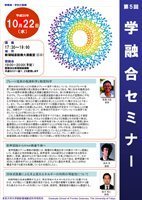AY2008 5th Gakuyugo Seminar
- Date&Time:
- Oct 22, 2008 17:30 - 19:00
- Venue:
- Large Lecture Room (2C0), New Frontier Science Bldg.

Observational science and material science of plate boundaries
Professor Mitsuhiro Toriumi
Most of the phenomena of the solid earth occur at plate boundaries. This is because the strain and heat release of solid earth materials are concentrated at plate boundaries. In particular, the real image of the plate boundary around the Japanese Islands has recently been observed on a large scale, and many facts have become clear. One of the most surprising findings was the discovery that the seismic wave velocity reduction rate and its ratio at the plate boundary are spatially heterogeneous, and that there is an overlap with the asperities, which are areas of strong mechanical coupling where large earthquakes frequently occur. In addition, the discovery of unstable sliding phenomena at plate boundaries, also known as slow or quiet earthquakes, has led to the identification of very long-period unstable sliding, and together with seismic sliding, it has become clear that broadband unstable sliding occurs at various boundaries. The mechanical behavior of such boundary areas is unstable sliding, which is a typical solid earth phenomenon that causes nonlinear behavior. It is possible to decipher the materials and conditions under which such phenomena occur from the temperature and pressure history, dehydration history, and mechanical coupling history of the rocks that were the plate boundary materials in the past. In fact, it was found that temporally heterogeneous dehydration reactions coupled with mechanical deformation, sliding behavior, crack formation, fluid movement, etc. caused unstable sliding. Such temporal and spatial variations of many physical quantities provide a new direction of research on the relationship between microfracture phenomena and megafracture at plate boundaries.

From Speech Recognition to RNA Structure Prediction
Professor Kiyoshi Asai
Speech recognition and genome decoding share a common engineering feature: pattern recognition of objects with a hierarchical structure. Behind the observable signals, such as speech signals and DNA sequences, there are hidden states, such as words and genes, and these hidden states are governed by rules of grammar and mechanics. In this paper, I would like to show how information analysis using probability models, which has been very successful in speech recognition, is also very effective in gene discovery and RNA structure prediction.

The Potential of Using Floating Wind Turbines for Offshore Wind Energy
Professor Hideyuki Suzuki
In order to build a sustainable society, it is important for Japan to consider how to position renewable energy. This paper looks at the use of the vast amount of wind energy that exists in the waters under Japan's jurisdiction from the perspectives of technology, economics, and environmental impact.
*The contents of this page were developed based on a machine translation.

